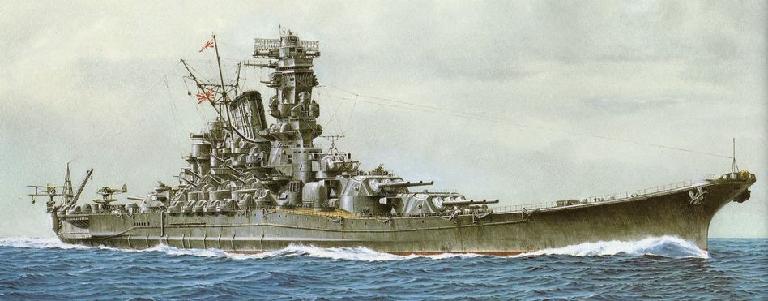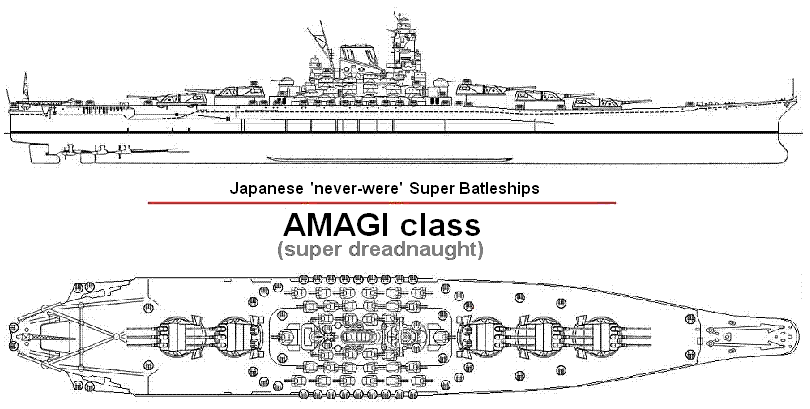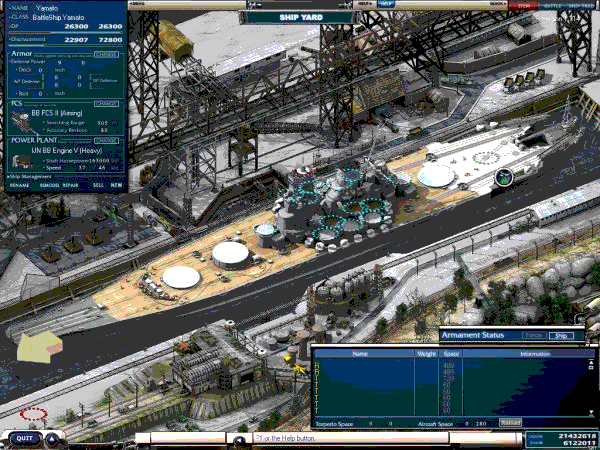
Imperial Japanese Navy - AMAGI class Super Battleship ==========================================================================
Super Battleships of Japan - plans that 'never-were'
During the second world war, almost all of the participating countries had plans for their own super class battleships. These are ships that for whatever reason - usually more pressing wartime programs - were designed but never built, although most were laid down. The intended superclass ships were the Montana class (US), Lion class (UK), 'H' class (Germany), and Sovyetskiy Soyuz class (USSR). However, none of these ships with the possible expception of the Montana class, would have been been a match with the Yamato and Musashi even if they were built. While others were planning their superclass ships, the Japanese already had built theirs. However, they had even further plans for the Yamato class. Warships number 798 and 799 were to be the first Super Yamato class battleships. These were designed in 1941 with construction scheduled to begin the following year, and with completion estimated for 1946. These ships were also referred to as design A-150. However, the orders were never actually placed, so any specifications are rudimentary at best.
The Amagi-class of super battleships were designed to have even greater fire power and size than the Yamato class, which were the largest battleships ever then built.
The Japanese had found that recoil and blast from the Yamato's 460 mm gun was significantly greater than the stresses of a 16-inch gun, requiring much heavier mountings, enclosed mounts for the secondary guns and special hangars for the ship's boats and aircraft. Blast from the 20-inch gun would probably have been at least twice that of a 16-inch gun. The reduction in the number of guns from nine to six would have resulted in turrets and mounts similar in weight to those of the Yamato but the rate of fire would probably have been lower.
Because most Japanese harbors were relatively shallow, the Super Battleship designs were very wide in order to reduce draft. This increased buoyancy and thus ability to survive underwater damage, but also lowered speed. The Amagi would presumably have been even wider because of the extra weight and would have had either more powerful machinery or a lower speed.
The Amagi design followed the Japanese pattern of attempting to build ships that were individually more powerful than foreign counterparts in order to offset the superior numbers that the United States, with its far superior shipbuilding capacity, could produce.
Japan also mistakenly assumed that the United States would not build battleships larger than the Iowas because such ships were too big for the Panama Canal, but the US broke that precedent with the proposed Montana-class battleships.
If Japan, the United States and Great Britain had completed all their planned battleships during the war, Japan would have had only five Yamatos and two Super Yamatos against 17 new American and nine new British battleships (the King George V and Lion-class battleships). As it was, the United States built ten battleships (the North Carolina-, South Dakota-, and Iowa-class battleships) and the British five (King George Vs), while the Japanese completed two.
American and British battleships also had the technological advantages of superior gunnery, radar and speed, the former giving an improved chance of inflicting damage while the latter improved deployment. Japanese battleships had far superior armor and anti-ship weaponry, and some unique design features that gave them various advantages.

In 1934, Japanese League of Nations delegates were angered by sanctions imposed on their country by that organization over the Manchurian Affair and Japan withdrew from that august body and renounced all naval treaty obligations. Soon after, long term plans were considered along with the possible actions and reactions of foreign nations, particularly potential adversaries such as the United States. Along with the preliminary design of the future YAMATO class, plans were drawn up that, hopefully, would allow Japan's pace for expansion to remain unhindered without triggering a war with America until the fleet was ready. The Japanese Imperial Navy attempted to build ships with which it was hoped "peace" could be maintained throughout the Pacific Rim by intimidation alone. The cornerstone of this belief was the battleship YAMATO armed with the highly secret 18-inch gun.
In the years before World War II the IJN began to structure itself specifically to fight the United States. A long stretch of militaristic expansion and the start of the Second Sino-Japanese war in 1937 had alienated the United States, which was seen as a rival of Japan for control of the Pacific.
According to these long-term plans, battleship superiority was to begin in 1936, with the construction of 7 YAMATO class ships, each with nine 18-inch guns, which would enter service in 1941. During this same time period, it was believed the United States would begin building an unknown number of new battleships armed with 16-inch guns. As the YAMATOS entered service, construction would start on four SUPER YAMATO battleships, armed with six 20-inch guns, two of which became designs 798 and 799; with completion estimated for 1946. Again, during this time period America, it was believed, would probably begin service with her new 16-inch gunned battleships and start constructing the first ships armed with the 18-inch weapon. In 1946, Japan felt she would then begin rearming the seven original YAMATO class ships with six 20-inch guns at the same time the four SUPER YAMATOS entered service. America, in 1946, would commission her first 18-inch armed battleships and begin building the first 20-inch gunned ships that Japan felt could not ready before 1951. By 1946 with this plan, Japan would have at least eleven battleships armed with 20-inch guns on duty and, Japanese naval authorities believed, capable of handling any threat the US Navy battle line could mount. Victory could be assured by intimidation alone with their "Peace Goddesses of the Pacific," and if war was unavoidable, Japan's super battleships would be irresistible. "The side whose ships possessed the largest guns would win the battle." Of course, all this required the United States to act as predicted.
This plan did not count on Japanese Army warlords starting war with America so soon. Neither did it consider the aircraft carrier, and five ESSEX class fleet carriers and five INDEPENDENCE class light carriers were building by 1941, with seven fleet carriers already in service.
The veil of secrecy surrounding the 18-inch gun held up well. American officials never knew Japan was building ships armed with the 18-inch gun until after the war. The United States did not plan to arm any ships with that weapon until 1944. If war had not broken out when it did, in theory, Japan could have had eleven ships with 18-inch guns against the US Navy's seventeen new battleships (BB-55 USS NORTH CAROLINA to BB-71 USS LOUISIANA), all armed with 16-inch guns. Despite the fact that neither their economy nor industrial capacity would support it, in 1936
Japanese officials drew up plans for a "dream fleet" that was to be ready by 1950. It included 19 battleships.
All this speculation and planning was conducted in the early 1930s, during a lull in the various worldwide ship building programs.
Among the Japanese naval architects at that time, was Captain (for shipbuilding) Kikuo Fujimoto, the chief designer in the Naval Technical Bureau. His design clearly showed a vessel which could out-gun anything afloat.
Unfortunately for Fujimoto, just before the plans for his creation was to be announced to the Naval High Command, a torpedo boat he designed capsized in a storm and he was relieved of his post due to the disgrace. The office was assumed by Rear Admiral Keiji Fukuda who headed teams that brought-forth more design studies.
In 1935, he proposed a fast battleship with all its heavy guns forward, possibly as a counter to HMS NELSON and RODNEY. The design was called A140-A and it is believed to be the original design for YAMATO:
In Admiral Fukuda's A-140 designs, some of the traditional Japanese characteristics are evident, such as the "pagoda" style superstructure amidships, and thick armor protection, rather than minute compartmentation. This feature is the so-called "direct system" of protection, while ships with many, small compartments are said to have "indirect" protection. Part of the design called for the future replacement of the 18.1-inch guns with 20-inchers and this foresaw a most difficult problem that was already being felt with the smaller weapons: gun blast. When guns of such size are fired, the resulting blast effect and vibration aboard ship can be devastating if not addressed in the design phase. Machine shops can become disabled, radar and other electronic equipment can malfunction, the optics in rangefinders can crack or come out of alignment, boats and other gear stowed on deck can be damaged or blown overboard, etc. One approach to solving the gun blast problem was to concentrate the main battery together (usually forward) and simply not allow any material or structure near them that might present difficulties when the big guns were fired. The disadvantages of such an arrangement, include the possibility of a lucky hit taking out most, if not all, the main battery and that the ship cannot fire dead astern, if necessary.
Another designer who contributed to Japan's future battleship program was Vice Admiral Dr. Yuzuru Hiraga, director of the Naval Technical Research Laboratory. Hiraga presented his own private ideas of future battleships for his nation. They stressed heavy armor protection and reduced the areas requiring this protection by squeezing the main battery and superstructure together as closely as possible. In all, the Hiraga design team proposed numerous designs (too numerous to go into here).
In addition to being the heaviest battleships ever constructed, and mounting the largest guns ever to go to sea, they were simply very beautiful ships. The rakish bow (like the IOWA class), flowed aft past the tall, vertical superstructure and rearward canted funnel, to give an almost "streamlined" appearance. The secondary battery of six 6-inch guns (originally twelve) and anti-aircraft guns and gun tubs were clustered around the superstructure, giving the open decks a very clean appearance. Her three massive 18-inch gun turrets, two forward one aft, each weighing 2,510 tons (without ammunition), seemed to blend into this sleek structure with no difficulty whatsoever.
One very fascinating factor about the ammunition: since Japan suffered heavy losses in her naval aviation community early in the war, capital ships were expected to provide their own defense against allied aircraft. As a result of this, the 18-inch gun was provided with an anti- aircraft shell of its own, called "San Shiki" (the Beehive) Model 13. This round weighed 2,998 pounds and was filled with 900 incendiary tubes (of rubber thermite) and 600 steel stays. A time fuze was supplied, set before firing, that went off at a predetermined altitude and when the fuze functioned, the explosive and metal contents burst in a cone extending 20 degrees forward, towards the oncoming aircraft. Instantly after detonating, the projectile shell itself was destroyed by a bursting charge, increasing the quantity of steel splinters. The incendiary tubes ignited about half a second later and burned for five seconds at 3000 degrees C, producing a flame about 16 feet long.
While there were rumors concerning Japanese "super ships" with 18-inch guns circulated with the US Intelligence community, in December 1942, the Office of Naval Intelligence (ONI) listed YAMATO and her sister ship MUSASHI with approximately the correct length but with far too little beam (110 rather than the correct 127') and displacing 40,000 to 57,000 tons. As late as July 1945, they were still thought to carry a main battery of 9 16- inch guns.
The third ship in the YAMATO class began life as WARSHIP NUMBER 110. Laid down in May 1940, it was believed she would not to be completed before 1945. Following the highly successful attack on Pearl Harbor, which showed the growing importance of air power, the Japanese were reluctant to commit the necessary manpower, construction space and money on another battleship. The work force was drastically reduced and the hull was to be completed only enough to float it out of the dock to clear that facility for other construction. The hull was 45% complete when, in June 1942, the decision was made to convert Number 110 into an aircraft carrier and name her SHINANO. This decision was a direct result of Japan's staggering loss of four carriers at the Battle of Midway that same month. As a carrier she was to carry 20 fighters, 20 bombers and 7 scouts. Ten days after her commissioning on 19 November 1944, SHINANO was steaming from Yokosuka to Kure to pick up her air wing. Submarine USS ARCHERFISH spotted her while patrolling the entrance to Tokyo Bay and fired six torpedoes, of which four struck. Six hours later, SHINANO sank with 75% of her crew.
Like SHINANO, neither MUSASHI or YAMATO survived the war. On 24 October 1944, while participating in the Battle for Leyte Gulf, MUSASHI was attacked by aircraft from USS ENTERPRISE, CABOT, INDEPENDENCE and INTREPID. Over a 4 1/2 hour period, she was hit by 17 bombs and 20 torpedoes and sank taking 1,023 officers and men with her, 43% of her complement.
YAMATO ended her career, as the ultimate kamikaze. On 6 April 1945, she sailed with one light cruiser and nine destroyers from Japan's Inland Sea with orders to attack the US invasion fleet around Okinawa (1,500 ships). After fighting her way through, she was to beach herself on Okinawa and become a fortress to aid the defenders against the American ground troops. The next day, while still 270 miles north of Okinawa, the force was attacked by many aircraft from Task Force 58. YAMATO took 13 torpedoes, 8 bombs and sank, killing 3,063 men.
WARSHIP NUMBER 111, never named, was to be the fourth YAMATO. Work was stopped when the hull was 30% complete in November 1941. The order was canceled in September the following year.
WARSHIP NUMBER 797, also never named, was to be the fifth YAMATO class battleship. This vessel was to have two 155mm triple turrets removed and replaced with a large battery of 100mm anti-aircraft guns. No construction order was ever placed.
WARSHIP NUMBER 798 and 799 were to be the first SUPER YAMATO class battleships. These were designed in 1941 with construction to begin the following year. The orders were never placed, so any specifications are rudimentary at best. These ships were also referred to as design A-150.
Additional protection was planned and full-scale models of the magazines and handling rooms for the turrets were constructed. Ballistic tests were conducted on the 20-inch gun with an AP round that weighed 4,188 lbs! No examples of this gun were ever found after the war. No further preparations were carried out on these ships due to the changing strategic situation after 1942.
There are frustratingly few details on four ships that were to be the ultimate Japanese battleship. Designed in 1941, it is uncertain when these were to begin building. These four, all unnamed, were to each carry eight 20-inch guns, and displace some 100,000 tons (SUPER DUPER YAMATOS ? one possibly to be named AMAGI "heavenly castle"). Unfortunately, no further specifics are available.
=================================================================================
NB: The above text has been collected / excerpted / edited / mangled / tangled / re-compiled / etc ... from the following online sources :
IJN - SUPER YAMATO class Battle Ship - wikipedia article #1
IJN - SUPER YAMATO class Battle Ship - www.battleshipyamato.info
IJN - 'never-were' Super Battleships of Japan - www.ibiblio.org
'never-were' Super Battleships of WWII - www.wolfsshipyard.mystarship.com


